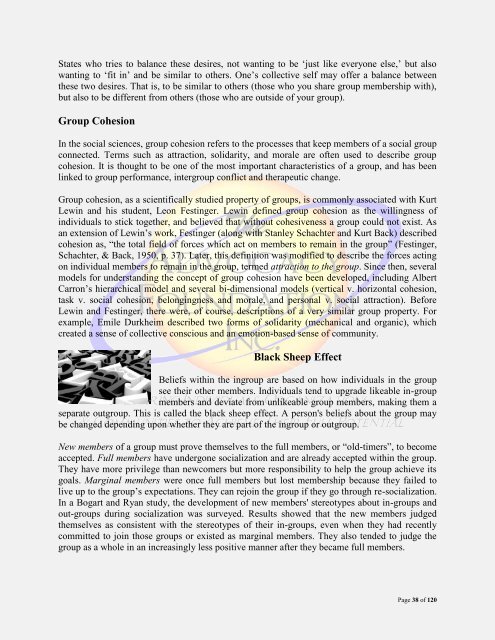Organizational Development - Vol. V, Part II
Organizational Development - Vol. V, Part II
Organizational Development - Vol. V, Part II
You also want an ePaper? Increase the reach of your titles
YUMPU automatically turns print PDFs into web optimized ePapers that Google loves.
States who tries to balance these desires, not wanting to be ‗just like everyone else,‘ but also<br />
wanting to ‗fit in‘ and be similar to others. One‘s collective self may offer a balance between<br />
these two desires. That is, to be similar to others (those who you share group membership with),<br />
but also to be different from others (those who are outside of your group).<br />
Group Cohesion<br />
In the social sciences, group cohesion refers to the processes that keep members of a social group<br />
connected. Terms such as attraction, solidarity, and morale are often used to describe group<br />
cohesion. It is thought to be one of the most important characteristics of a group, and has been<br />
linked to group performance, intergroup conflict and therapeutic change.<br />
Group cohesion, as a scientifically studied property of groups, is commonly associated with Kurt<br />
Lewin and his student, Leon Festinger. Lewin defined group cohesion as the willingness of<br />
individuals to stick together, and believed that without cohesiveness a group could not exist. As<br />
an extension of Lewin‘s work, Festinger (along with Stanley Schachter and Kurt Back) described<br />
cohesion as, ―the total field of forces which act on members to remain in the group‖ (Festinger,<br />
Schachter, & Back, 1950, p. 37). Later, this definition was modified to describe the forces acting<br />
on individual members to remain in the group, termed attraction to the group. Since then, several<br />
models for understanding the concept of group cohesion have been developed, including Albert<br />
Carron‘s hierarchical model and several bi-dimensional models (vertical v. horizontal cohesion,<br />
task v. social cohesion, belongingness and morale, and personal v. social attraction). Before<br />
Lewin and Festinger, there were, of course, descriptions of a very similar group property. For<br />
example, Emile Durkheim described two forms of solidarity (mechanical and organic), which<br />
created a sense of collective conscious and an emotion-based sense of community.<br />
Black Sheep Effect<br />
Beliefs within the ingroup are based on how individuals in the group<br />
see their other members. Individuals tend to upgrade likeable in-group<br />
members and deviate from unlikeable group members, making them a<br />
separate outgroup. This is called the black sheep effect. A person's beliefs about the group may<br />
be changed depending upon whether they are part of the ingroup or outgroup.<br />
New members of a group must prove themselves to the full members, or ―old-timers‖, to become<br />
accepted. Full members have undergone socialization and are already accepted within the group.<br />
They have more privilege than newcomers but more responsibility to help the group achieve its<br />
goals. Marginal members were once full members but lost membership because they failed to<br />
live up to the group‘s expectations. They can rejoin the group if they go through re-socialization.<br />
In a Bogart and Ryan study, the development of new members' stereotypes about in-groups and<br />
out-groups during socialization was surveyed. Results showed that the new members judged<br />
themselves as consistent with the stereotypes of their in-groups, even when they had recently<br />
committed to join those groups or existed as marginal members. They also tended to judge the<br />
group as a whole in an increasingly less positive manner after they became full members.<br />
Page 38 of 120

















